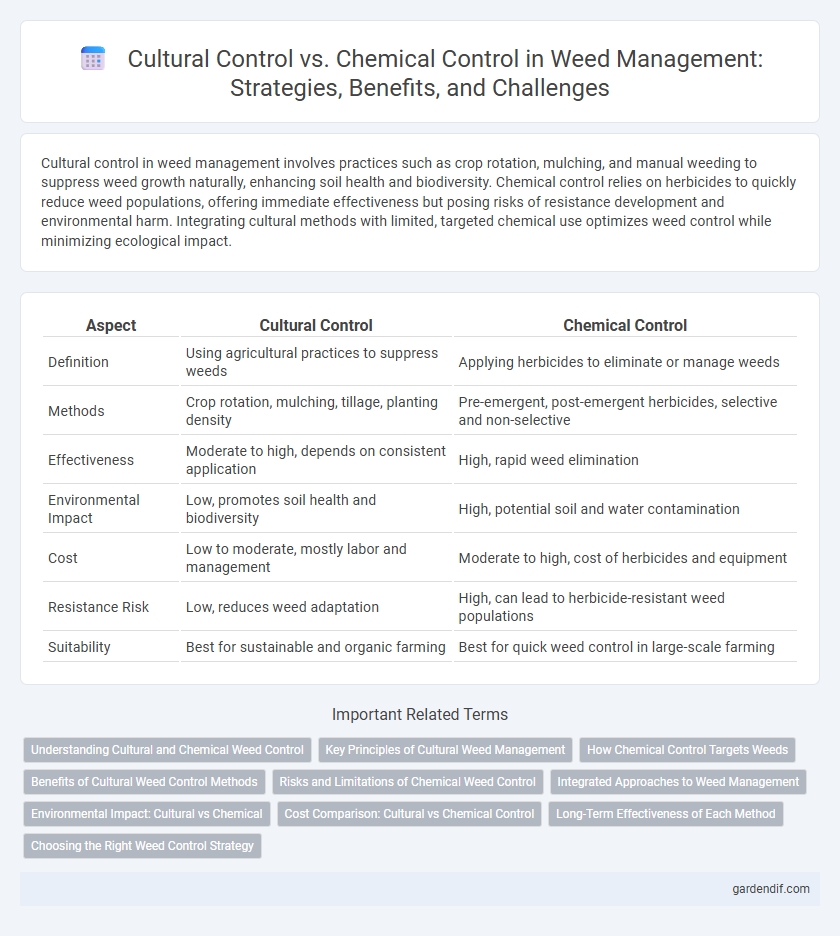
Cultural Control vs Chemical Control Illustration
Cultural control in weed management involves practices such as crop rotation, mulching, and manual weeding to suppress weed growth naturally, enhancing soil health and biodiversity. Chemical control relies on herbicides to quickly reduce weed populations, offering immediate effectiveness but posing risks of resistance development and environmental harm. Integrating cultural methods with limited, targeted chemical use optimizes weed control while minimizing ecological impact.
Table of Comparison
| Aspect | Cultural Control | Chemical Control |
|---|---|---|
| Definition | Using agricultural practices to suppress weeds | Applying herbicides to eliminate or manage weeds |
| Methods | Crop rotation, mulching, tillage, planting density | Pre-emergent, post-emergent herbicides, selective and non-selective |
| Effectiveness | Moderate to high, depends on consistent application | High, rapid weed elimination |
| Environmental Impact | Low, promotes soil health and biodiversity | High, potential soil and water contamination |
| Cost | Low to moderate, mostly labor and management | Moderate to high, cost of herbicides and equipment |
| Resistance Risk | Low, reduces weed adaptation | High, can lead to herbicide-resistant weed populations |
| Suitability | Best for sustainable and organic farming | Best for quick weed control in large-scale farming |
Understanding Cultural and Chemical Weed Control
Cultural weed control involves practices like crop rotation, mulching, and planting cover crops to suppress weed growth by enhancing crop competitiveness and disrupting weed life cycles. Chemical weed control uses herbicides to selectively target and eliminate weeds, providing rapid and effective management especially in large-scale or high-density infestations. Integrating both methods optimizes weed management by reducing chemical reliance, minimizing environmental impact, and improving long-term crop health.
Key Principles of Cultural Weed Management
Cultural weed management focuses on preventive practices such as crop rotation, planting density optimization, and timely irrigation to suppress weed growth by enhancing crop competitiveness. It relies on ecological principles to reduce weed seed bank and minimize reliance on chemical herbicides, promoting sustainable agriculture. Techniques like mulching and mechanical cultivation disrupt weed cycles and improve soil health, leading to long-term control and reduced environmental impact.
How Chemical Control Targets Weeds
Chemical control targets weeds by using herbicides specifically formulated to disrupt vital physiological processes such as photosynthesis, amino acid synthesis, or cell division, leading to weed mortality. Selective herbicides are designed to affect particular weed species without harming desired crops, whereas non-selective herbicides eliminate all vegetation within the treated area. Effective chemical control requires understanding weed biology, proper herbicide selection, and application timing to enhance efficacy and minimize environmental impact.
Benefits of Cultural Weed Control Methods
Cultural weed control methods enhance soil health and biodiversity by promoting natural weed suppression through crop rotation, cover cropping, and proper irrigation management. These practices reduce reliance on chemical herbicides, minimizing environmental contamination and resistance development in weed populations. Implementing cultural controls supports sustainable agriculture by improving ecosystem resilience and long-term weed management efficacy.
Risks and Limitations of Chemical Weed Control
Chemical weed control poses significant risks including the development of herbicide-resistant weed populations and potential contamination of soil and water resources. Limitations such as application timing sensitivity, the need for repeated treatments, and adverse effects on non-target organisms reduce its long-term effectiveness. These factors make reliance solely on chemical control unsustainable compared to integrated or cultural weed management practices.
Integrated Approaches to Weed Management
Integrated approaches to weed management combine cultural control methods such as crop rotation, cover cropping, and mechanical tillage with targeted chemical control to reduce herbicide resistance and environmental impact. Cultural practices enhance crop competitiveness and soil health, limiting weed establishment while minimizing reliance on synthetic herbicides. This synergy improves long-term weed suppression and sustainability in agricultural systems.
Environmental Impact: Cultural vs Chemical
Cultural control methods such as crop rotation, mulching, and mechanical weeding significantly reduce environmental impact by minimizing chemical runoff and preserving soil biodiversity. Chemical control, while effective in rapidly reducing weed populations, often leads to contamination of water sources, development of herbicide-resistant weed species, and harm to non-target organisms like pollinators and soil microbes. Implementing cultural control strategies promotes sustainable weed management and protects ecosystem health over the long term.
Cost Comparison: Cultural vs Chemical Control
Cultural control methods for weed management, such as crop rotation and mulching, often incur lower long-term costs compared to chemical control, which requires repeated purchases of herbicides and application equipment. While chemical control may provide faster immediate results, the cumulative expenses of herbicides, environmental compliance, and potential resistance development can lead to higher overall investment. Integrating cultural practices reduces dependency on chemicals, resulting in sustainable weed management with cost efficiency over multiple growing seasons.
Long-Term Effectiveness of Each Method
Cultural control methods, such as crop rotation and cover cropping, promote long-term weed suppression by enhancing soil health and disrupting weed life cycles, resulting in sustainable weed management over multiple growing seasons. Chemical control, relying on herbicides, offers immediate weed population reduction but carries risks of resistance development and environmental impact that can undermine long-term efficacy. Integrating cultural practices with targeted chemical applications maximizes weed control durability while minimizing ecological risks.
Choosing the Right Weed Control Strategy
Selecting the right weed control strategy requires evaluating the specific weed species, crop type, and environmental conditions to maximize effectiveness and sustainability. Cultural control methods, such as crop rotation, cover cropping, and mechanical tillage, reduce weed pressure by enhancing crop competitiveness and disrupting weed life cycles without chemical inputs. Chemical control, involving targeted herbicide application, offers rapid weed suppression but must be integrated carefully to prevent resistance development and environmental harm.
Cultural Control vs Chemical Control Infographic

 gardendif.com
gardendif.com